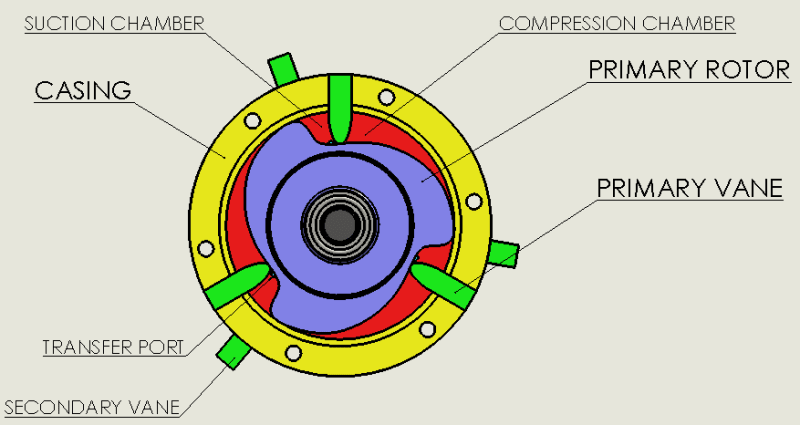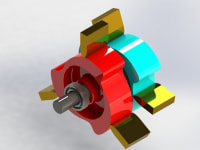The theory of the continuous power stroke rotary engine, CPSRE, is designed to reduce the loss of energy that occurs while transferring the combustion energy to the output shaft. In CPSRE, the energy produced by combustion is transferred to the rotor which is directly keyed to the output shaft.
The CPSRE has a ratchet like rotor with smooth edges, which is placed inside a circular casing. Spring loaded vanes are placed in radial direction along the casing as shown in figure. The rotor vanes and casing has an oil seal between them, which forms a chamber between each vane, rotor teeth and casing. CPSRE consists of two rotors on either side of the casing and is locked to the same shaft. The two rotors are locked to the output shaft at a given angular offset between their teeth. The primary rotor is for induction and compression of air and the secondary rotor for combustion and exhaustion.
When the rotor rotates the volume in front of the vane increases and it sucks in air-fuel mixture and the volume behind the vane decreases which compresses the mixture which was sucked during the previous stage. This compressed air-fuel mixture is transferred to the secondary rotor through a transfer port. The mixture is ignited in the combustion chamber and it pushes the rotor forward. During the next stage the burned gases is pushed out through the exhaust port.
For a rotor with 3 teeth there will be 9 power strokes in one complete rotation of the output shaft. In every instant there is an induction, compression, combustion and power stroke. Since the rotor is symmetrical there is no need for a balancing weight. Rotor itself can act as a flywheel since it is mounted on a center shaft, thus reducing size and weight of the engine.
In rotary Wankel engine, rotor is connected to an eccentric shaft and uses a timing gear, but in CPSRE rotor is directly keyed to the output shaft.
CPSRE can be used in everywhere a reciprocating engine can be used. By using rotor with different number of teeth according to size of the engine, it might prove better than a conventional engine to certain applications. Compact size and lesser weight is an ideal option for automobile application. With no need for a valve or its accompanying arrangements, number of parts is reduced which will greatly reduce cost and time of production.
With the simplest designs all the main parts can be machined on a 3-axis CNC milling and a CNC lathe. The challenging task though is ensuring an airtight seal between the parts for a long time.
Video
Like this entry?
-
About the Entrant
- Name:Joju Zacharias
- Type of entry:individual
- Software used for this entry:solidworks
- Patent status:none





